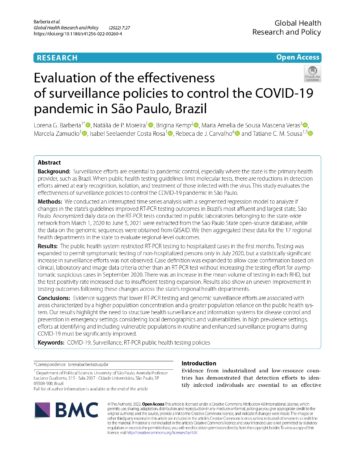Abstract
Background: Surveillance efforts are essential to pandemic control, especially where the state is the primary health provider, such as Brazil. When public health testing guidelines limit molecular tests, there are reductions in detection efforts aimed at early recognition, isolation, and treatment of those infected with the virus. This study evaluates the effectiveness of surveillance policies to control the COVID-19 pandemic in São Paulo.
Methods: We conducted an interrupted time series analysis with a segmented regression model to analyze if changes in the state’s guidelines improved RT-PCR testing outcomes in Brazil’s most affluent and largest state, São Paulo. Anonymized daily data on the RT-PCR tests conducted in public laboratories belonging to the state-wide network from March 1, 2020 to June 5, 2021 were extracted from the Sao Paulo State open-source database, while the data on the genomic sequences were obtained from GISAID. We then aggregated these data for the 17 regional health departments in the state to evaluate regional-level outcomes.
Results: The public health system restricted RT-PCR testing to hospitalized cases in the first months. Testing was expanded to permit symptomatic testing of non-hospitalized persons only in July 2020, but a statistically significant increase in surveillance efforts was not observed. Case definition was expanded to allow case confirmation based on clinical, laboratory and image data criteria other than an RT-PCR test without increasing the testing effort for asymptomatic suspicious cases in September 2020. There was an increase in the mean volume of testing in each RHD, but the test positivity rate increased due to insufficient testing expansion. Results also show an uneven improvement in testing outcomes following these changes across the state’s regional health departments.
Conclusions: Evidence suggests that lower RT-PCR testing and genomic surveillance efforts are associated with areas characterized by a higher population concentration and a greater population reliance on the public health system. Our results highlight the need to structure health surveillance and information systems for disease control and prevention in emergency settings considering local demographics and vulnerabilities. In high prevalence settings, efforts at identifying and including vulnerable populations in routine and enhanced surveillance programs during COVID-19 must be significantly improved.
Keywords: COVID-19, Surveillance, RT-PCR public health testing policiesRelative to 2019, the risk of SARI hospitalization in 2021 was 4.7 higher, and deaths have increased by 2 in this age group.


